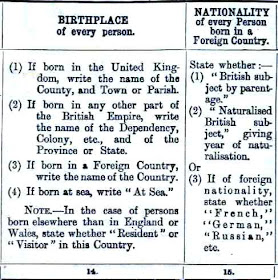I hope everyone else had a successful time yesterday with the release of the 1911 Census for Scotland on
ScotlandsPeople. I found three of my four grandparents - two of them before the official launch time of 11am BST. Optimists usually log on a little early, and sometimes it pays off.
I wasn't relying on this census to help me make any great breakthroughs, and I didn't make any astonishing discoveries, but there were a few surprises. I found extra family members, and filled in a few gaps.
The 'fertility in marriage' question revealed the existence of hitherto unsuspected infants who had died. I knew this was a possibility, because I had seen many people make such a discoveries in the 1911 Census of England and Wales over the last two years. All the same, it still gave me quite a jolt to find that my grandmother was one of
five sisters, not three as we had always thought. In some ways this is one of the most rewarding things about researching family history, finding and recording the short lives of children who are quite closely related to me, but who literally have been forgotten.
This was the first time I had seen one set of my grandparents in the census, as this pair were born after 1901. By contrast with the discovery of my grandmother's two extra sisters, I found no new people in my grandfather's family, but it was an interesting census entry all the same. I already know quite a lot about the family, which is lucky, because the way they appear in this census would be misleading if I didn't. In the England and Wales 1911 Census, I have seen a number of schedules where the householders were evidently confused by some of the questions, and although in Scotland we only see what the enumerator has copied up, I think I this one was probably a bit of a mess. They lived at 76 McAlpine Street, which was still standing in the 1960s, and there is a picture of 64-84 McAlpine Street on the excellent
Virtual Mitchell site, which has lots of images of Glasgow.
It was a three-generation household, which can be a good source of confusion to start with. It confirms what my grandpa told me, that he lived with his grandparents, and I was pleasantly surprised to find his grandfather, Thomas Cross, making his first and only census appearance; Thomas was an Irishman in the merchant navy, so he had always been out of reach before. The household appears to consist of Thomas and Jane Cross, two daughters in their 20s, Ellen J and Margaret Cross, four visitors, and Jane Cross, aged 3 described as a relative. But the two daughters are listed as married, with the fertility in marriage details given, even though they have the Cross surname. The visitors are Ellen Collins and Maggie J Allison, also in their 20s, and married, and two small children, Henry and Ellen J Collins. The sisters are listed twice, under both their maiden and married names.
Well, I have seen duplicate entries in the census before, but never two people listed twice in the same household! Little Henry is my grandpa, and his sister is my great-aunt Agnes. And I do mean Agnes; he did have a sister called Ellen, but she wasn't born until 1916! He also had a brother, Robert, born in 1910, but goodness knows where he is! The 'relative', Jane Cross, is Margaret/Maggie's daughter who was born a couple of months before she married Fred Allison in 1906.
I am very glad that I already have a couple of decades' worth of research on this family, because if I were starting with this census entry I'd be very confused. I have plenty of birth, marriage and death certificates and other records for these people, so I can be confident that the family just made a complete dog's breakfast of filling in the form! One of the things that I know from the certificates is that Jane Cross and her daughters could not write; they all made their mark instead of signing on every document I have seen. I have no evidence either way on Thomas, but we are clearly not dealing with a very literate family here. The completed enumeration book is neatly written and very legible, but I can just imagine the poor enumerator tearing his hair out trying to make sense of what must have been a pretty horrible-looking piece of paper, full of crossings-out, or else he had to ask them the questions and try to make sense of their answers.
So I will take this opportunity to apologise publicly to the descendants of the poor man, one T S Taylor, on behalf of the combined Cross, Collins and Allison families. Sorry. I will see that it doesn't happen again.



























